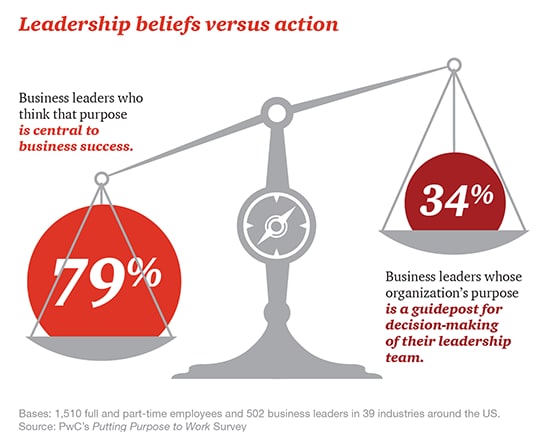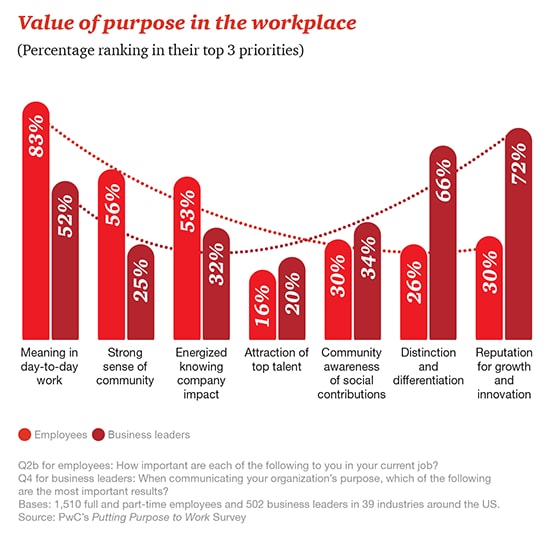One of the greatest disconnects in the corporate world involves purpose, and, therefore, it’s one of the greatest opportunities for leaders who want to improve their organizations.
This was illustrated perfectly in a few graphics I saw in a 2016 report by PWC. One graphic showed that nearly 8 out of 10 leaders said purpose was important to their success but fewer than 4 out 10 said it guided their decisions. That’s a disconnect.

A second chart showed seven reasons why purpose might be a priority to someone. Respondents were asked to rank their top three, and there was a dramatic difference between what leaders prioritized about purpose and what their employees prioritized.

For employees, the top priorities were around the meaning purpose gave to their daily work, the sense of community it fostered, and the energy they got from knowing the company was making a positive impact. For leaders, the value was in things like building the company’s reputation for growth and innovation, creating differentiation in the market, building community awareness, and attracting talent.
Leaders and employees have different roles, of course, and that partly explains why they prioritize things differently. But the differences in how the two groups valued purpose turned into a disconnect when the survey results revealed that “few business leaders guide supervisors to have conversations with their teams about why their work matters.”
In other words, leaders and managers were doing a poor job of helping employees connect to purpose in ways that mattered to them the most. Why? Because leaders were either unaware of what mattered to employees or they were too focused only on what mattered to themselves.
The first thing leaders can do to resolve these disconnects is recognize that they exist. Then they can take two steps toward communicating purpose in positive, productive ways.
1. State It Clearly and Effectively
Some organizations are great when it comes to clearly and effectively stating their purpose. Nike talks about bringing inspiration and innovation to every athlete in the world. Google talks about organizing the world’s information and making it universally accessible and useful. CVS talks about being the easiest pharmacy retailer for customers to use. Walmart does it in four words: Save money. Live better.
Unfortunately, when I was at Prologis (1994-2012), we didn’t spend enough time articulating our vision. Prologis is the world’s largest owner of warehouse space, and the company has long played an important role in the logistics and supply chain industry. We understood our business purpose, but we didn’t state it ways that inspired customers or employees to rally around it.
I’m happy to say that in recent years the leadership team has been more intentional about bringing the company’s purpose to life: “We help customers facilitate timely delivery that makes modern life possible.”
That type of stated purpose, however, is but one piece of the puzzle. It tells employees and the world what you do as a business, but it doesn’t necessarily convey what you stand for when it comes to making a difference in the lives of people. That part of the purpose may or may not be communicated to the world, but it is essential that it’s communicated to employees.
Leaders and managers were doing a poor job of helping employees connect to purpose in ways that mattered to them the most. Why?
Prologis has a solid history of listening to employees to learn what’s important to them and communicating a shared message about values. But that was, and is, mostly done internally. Some businesses, of course, do this in more overt ways. Patagonia’s mission statement says, “We’re in business to save our home planet.” But that, too, is just one piece of their purpose. In some form, Patagonia still must convey a message that says, “We make clothing for outdoor enthusiasts.”
Leaders need to clearly articulate all the important aspects of purpose, and they need to do it in multiple ways as an on-going effort. Formal mission, vision, and purpose statements are great. But purpose – what you do and what you stand for – also should show up in emails, videos, small meetings, large meetings, on the company intranet, in social media … everywhere communication happens.
Never miss a post about leadership, transparency, and trust by signing up for my weekly mailing list, delivered right to your inbox. Sign up here.
2. Show It in Your Actions
Stating your purpose clearly and effectively is important, but backing it up with business decisions, financial investments, and tangible actions around that purpose is even more powerful.
Since Prologis is involved in the supply chain, for instance, we established a global “Space for Good” program that made our warehouses available for community causes and disaster relief efforts. We also worked with employees around the world to identify and support the issues that mattered most to them. Employees helped build schools in China and playgrounds for kids in Romania, volunteered at hospitals in Poland, organized fund-raising bike races in England, and worked with inner-city youth organizations in the U.S.
By listening to our employees, we found that environmental stewardship and sustainability were important issues to many of our workers and customers around the world. So, we invested in solar energy panels that went on top of some of our warehouses, we looked more closely at how we sourced materials for our buildings and how we could make them more energy efficient, and we spent extra money to educate and certify our workforce in an effort to gain higher environmental awareness.
The PWC study drove home the reality that employees want to make their communities better, and I believe leaders have a responsibility to help them do it. When leaders enable employees to live out their values by helping others, their employees find greater purpose and meaning in their work.
Leaders today can’t just talk a good game about purpose. We have to live it personally and we have to take actions that make it part of the DNA of our organizations. If not, the disconnect will become obvious and our employees, customers, and bottom line will all suffer. But investing in purpose creates alignment and energy, and positive results are sure to follow.
